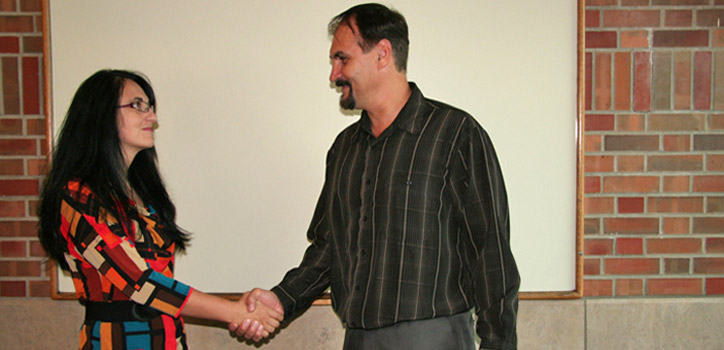Article

New neuroscience research is confirming an old adage about the power of a handshake: strangers do form a better impression of those who proffer their hand in greeting.
A firm, friendly handshake has long been recommended in the business world as a way to make a good first impression, and the greeting is thought to date to ancient times as a way of showing a stranger you had no weapons. Now, a paper published online and for the December print issue of the Journal of Cognitive Neuroscience on a study of the neural correlates of a handshake is giving insight into just how important the practice is to the evaluations we make of subsequent social interactions.
The study was led by Beckman Institute researcher Florin Dolcos and Department of Psychology postdoctoral research associate Sanda Dolcos. They found, as they wrote, that “a handshake preceding social interaction enhanced the positive impact of approach and diminished the negative impact of avoidance behavior on the evaluation of social interaction.”
Their results, for the first time, give a scientific underpinning to long-held beliefs about the important role a handshake plays in social or business interactions. Sanda Dolcos said their findings have obvious implications for those who want to make a good impression.
“I would tell them to be aware of the power of a handshake,” she said. “We found that it not only increases the positive effect toward a favorable interaction, but it also diminishes the impact of a negative impression. Many of our social interactions may go wrong for a reason or another, and a simple handshake preceding them can give us a boost and attenuate the negative impact of possible misunderstandings.”
The study focused experimentally on approach and avoidance behaviors in social interactions. Functional magnetic resonance imaging (fMRI), skin conductance, and behavioral responses were collected from18 male and female volunteers who watched and rated animated videos of non-verbal guest-host interactions in a business setting. Analysis of the fMRI data focused on brain areas from the social cognition network.
The results showed “increased sensitivity to approach than to avoidance behavior in amygdala and superior temporal sulcus, which were linked to a positive evaluation of approach behavior and a positive impact of handshake.” In addition, the researchers wrote, the “nucleus accumbens, which is a reward processing region, showed greater activity for Handshake than for No-handshake conditions” – thus demonstrating a link to “the positive effect of handshake on social evaluation.”
“The regions of the social cognition network are commonly engaged when people are assessing the intentions of others,” Florin Dolcos said. “They had been identified before and people who have difficulty in interactions, like people with autism, have reduced response in this region.
“But, unlike previous studies, we simulated approach and avoidance behaviors using animated characters that displayed obvious interest or indifference for further interactions. This is the first time that such a manipulation was used in a relevant context.”
The videos the participants watched included animated human figures in a setting that indicated a business-type interaction. The figures included a host and a guest encountering each other for the first time. Florin Dolcos said using animated videos with human figures interacting in a defined social context was a big step forward in this type of research.
“Previous research investigating social interactions has used static instead of dynamic social stimuli, or focused only on faces,” he said. “However, in everyday life people are typically involved in dynamic interactions with others in a defined social context. I think that is what sets this study apart.”
Sanda Dolcos summed up the results: “Overall, our study not only replicated previous reports that identify activity in regions of the social cognition network, but also provided insight into the contribution of these regions into evaluating approach and avoidance social interactions, and grant neuroscientific support for the power of a handshake.”
Florin Dolcos added that it’s not just any handshake that leads to positive feelings, but a particular way of shaking hands, such as a firm, confident, yet friendly handshake, as is often promoted as good business practice.
“In a business setting this is what people are expecting, and those who know these things use them,” he said. “Not a very long time ago you could get a loan based on a handshake. So it conveys something very important, very basic. Yet the science underlying this is so far behind. We knew these things intuitively but now we also have the scientific support.”
Florin Dolcos is a member of Beckman’s Cognitive Neuroscience group, heads the Dolcos Lab for Affective, Cognitive, and Clinical Neuroscience, and is Assistant Professor in the Department of Psychology.
Beckman Institute for Advanced Science and Technology